Menus
- Wild and brilliant roadster
- 4 cylinders in line, 1,135 cm3, 119 hp, 160 kg
- Genesis
- Discovery
- Test
- Cycle part
- Braking
- Conclusion
Wild and brilliant roadster
4 cylinders in line, 1,135 cm3, 119 hp, 160 kg
It has been exactly 40 years since New Zealander Graeme Crosby entered the GP 500 as factory Suzuki rider for the team led by British importer Heron Suzuki. He was then only 24 years old ! His arrival on the British racing scene in 1979 caused a sensation, because of the motorcycle he rode, the very straight and unfaired Kawasaki Z1B Superbike with its high handlebars which had been prepared by the then unknown small Japanese company Moriwaki..
Remember, the Superbike discipline had only just been invented in the USA three years earlier, with a first race contested at Daytona in 1976. This naked 4-stroke monster had no time to migrate to Europe. Anyway, the British federation had invented the TT Formula 1 in 1977, with production engines prepared in a racing chassis, in order to save the World Championship status of the Tourist Trophy. It also meant that American-style Superbike racing wouldn’t have a place for a decade. So, at this time when the full fairing and the bracelets handlebars were considered de rigueur on a racing motorbike, here is a New Zealander out of nowhere, sitting very upright on his Japanese road motorbike, with no exterior wrapping. of the small fork crown, came to face the local stars like Mick Grant and Ron Haslam who evolved them on the Honda factory. As one commentator pointed out at the time, "only a victory for a custom in the Senior TT would have made more noise!"
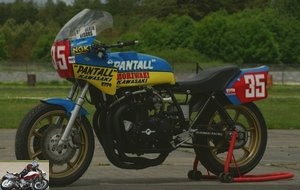 Moriwaki Kawasaki Z1B review
Moriwaki Kawasaki Z1B review
Genesis
Croz ‘was one of the most versatile and gifted pilots of his generation. He was also one of the most spectacular drivers the world has ever seen, making his mark on world-class road races in just four years. He exploded on the international scene in 1979 riding this improbable Kawasaki superbike on which he ended up between the two Hondas by finishing second in the British TT F1 championship. This earned him a contract for the Suzuki factory team in 80/81 in 500 GP and TT F1, allowing him to win the TT F1 world championship in the process and to win three times on the Isle of Man. Nothing less ! In 1982, he joined the Yamaha team newly formed by World Champion Giacomo Agostini and won the Daytona 200 for his first race. But although he finished second in the championship that year, Croz was then discouraged by the GP policy, so much so that he packed his bags and returned to New Zealand at the end of the season, retiring for good. the competition as his star was just starting to shine in the Grand Prix galaxy.
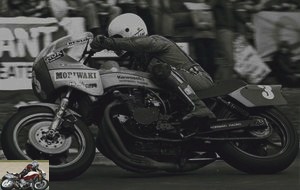 Crosby on the Moriwaki Kawasaki Z1B at the 1979 Ulster GP
Crosby on the Moriwaki Kawasaki Z1B at the 1979 Ulster GP
Famous for his gimmick when he came to every new track, “Which way is the track going and what’s the lap record?” Croz played his role as the hero of the people. Along with his regular wheelies that delighted the crowd, his rear drifts and his breathtaking overtaking, he also stood out for his witty cues. Combined with his carefree charm and confidence, his showmanship made him a pilot unanimously appreciated by fans around the world, with this ability to bring star pilots back to earth, both on and off the road. track. His antics and gaiety reflected a seemingly nonchalant approach to racing, but which in reality masked the analyzes of a fierce rival. Croz was running to win.
The history of road racing has seen several iconic rider and motorcycle duos, such as Ago and the 3-cylinder MV, Mike Hailwood and his Ducati from the TT or Mick Doohan on the Honda NSR500. Graeme Crosby and the Moriwaki Kawasaki Z1 make this list, especially after seeing him in action for most of the 1979 season, both from off the track as a friend and fan, but also closer to it was directly behind him on the starting grid of the TT F1 heats on my P&M Kawasaki.
I was lucky enough to be able to ride this bike on the Pembrey track in South West Wales and thus answer a question that I had been asking myself for 40 years: How efficient was the Moriwaki Kawasaki? and what role did she play in Croz’s ascent to the heights ?
 Graeme Crosby at the Mallory Park Festival of 1,000 Bikes
Graeme Crosby at the Mallory Park Festival of 1,000 Bikes
Discovery
Since the rules of TT Formula 1 limited the maximum displacement to 1,000 cc for 4-stroke (and 500 cc for 2-stroke), Mamoru Moriwaki could not use the Kawasaki Z 1000 introduced in 1977 as the basis for his TT F1 motorcycles. . It had a 1.015 cc engine. He therefore based the Crosby Superbike on the air-cooled engine of the Z1B from 1975, measuring 66 x 66 mm with a displacement of 903 cm3 with two overhead camshafts and fitted high compression pistons of 69.4 mm to reach 998.64 cm3 with a compression ratio of 11.5: 1. But when Gordon Pantall restored the engine, Moriwaki couldn’t supply these pistons. He therefore fitted 74 mm Omega pistons on the standard connecting rods, the cylinder being hollowed out to offer a final capacity of 1,135 cm3, or 14% more than on the Crosby version..
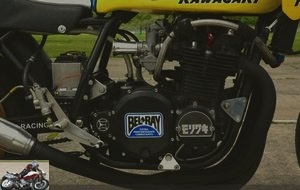 The four-cylinder Kawasaki cube engine now has 1,135 cm3
The four-cylinder Kawasaki cube engine now has 1,135 cm3
The eight-valve cylinder head with dual overhead camshafts was extensively revised by Moriwaki in Japan by being fitted with racing camshafts running on oversized 37.5mm steel valves at intake and 31mm at exhaust, carrying heavy-duty springs via Z650 inverted horns. Although under TT F1 rules Crosby was required to use the Z1B’s small 28mm road Mikuni carburetors, for Open class racing he rode 32mm stroke Keinhin CRs, which were still found on the machine today. An exact replica of the original Moriwaki 4-1 racing exhaust was purchased in Japan, with the exception of the aluminum muffler which replaces the original steel one. After experiencing problems with the original ignition, Pantall fitted a Dyna S electronic CDI powered by a 12V battery. The result is an engine that has been bench tested at 119 hp @ 9,000 rpm.A Kawasaki five-speed gearbox helps transmit that power to the ground through a stock wet multi-plate clutch..
 The Keihin carburetors of the revised Z1B engine
The Keihin carburetors of the revised Z1B engine
For the Moriwaki’s racing debut at the Suzuka 8 Hours in 1979, this same prepared engine was mounted on a modified Kawasaki Z1B frame with an open caster angle of 2 ° more than the original for more stability. . Z650 triple T’s were used, with a reduced offset for an extended length of 108mm versus the stock 90mm. While changing the steering geometry, Moriwaki also stiffened the chassis with bracing around the steering column and the front engine mount. It is this same modified Z1B frame that is still present on the bike, with additional reinforcements. There is also a Moriwaki swingarm with two 330mm long Kayaba shocks adjustable to 9 preload levels..
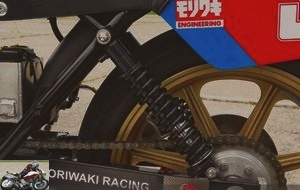 The shocks modified by Moriwaki are longer and more inclined than the original
The shocks modified by Moriwaki are longer and more inclined than the original
As these shocks are much longer than the stock components, they not only help to increase the forward weight on the tire, but also provide additional ground clearance, crucial when combined with the wide Moriwaki side covers. of the motor. The fact that the upper shock mounts have also been moved further forward on the frame provides a semi-recumbent position which induces additional progressiveness for the suspension. The 36mm Kayaba pneumatically adjustable preload fork features a 28 ° caster angle. The wide, flat, one-piece handlebars are bolted to the top triple triple-yoke by 40mm saddles providing additional leverage. There is also an adjustable Kawasaki steering damper on the right.
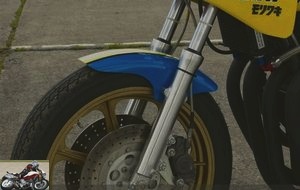 The fork angle has been opened to 28 °
The fork angle has been opened to 28 °
The two stainless steel 296mm Kawasaki front brake discs remain the only feature of the Moriwaki that is consistently troublesome, easily overheating under the bite of the two-piston AP-Lockheed calipers, whether on fast tracks like Silverstone or higher. slow like Scarborough. The 230 mm Kawasaki stainless steel rear disc with AP-Lockheed single-piston caliper provides additional slowing down, which is essential to brake the 160 kg dry claimed by this racing bike, compared to the 232 kg of the Z1B! This weight is also made possible by the extremely rare 18-inch Morris magnesium rims. Gordon Pantall had bought them new via the web when restoring the bike. Their light weight also helps to minimize unsprung weight and therefore improve suspension tuning. These are shod in vintage Dunlop racing tires with a KR125 3.50 / 3.25 on the 3 "front Morris wheel and a KR164 3.75 / 5.00 on the 4" rear..
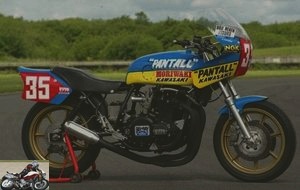 The Moriwaki Kawasaki Z1B weighs only 160 kg dry
The Moriwaki Kawasaki Z1B weighs only 160 kg dry
Test
The Moriwaki took a long time to start in the Paddock … using second gear! The first is indeed too low to be used elsewhere than at the start of a race. And this start was made only after having copiously flooded the Keihin CR carburettors. Once warmed up, the engine then suffered a high speed misfire on the track, a problem solved by replacing a new 12v battery..
But once it turns, Moriwaki’s prepared engine delivers impressive acceleration for an eight-valve four-cylinder. This is also where the larger 32 mm CR carburettors used for the Open category instead of the mandatory 28 mm in TT F1 would have shown all their interest on faster circuits..
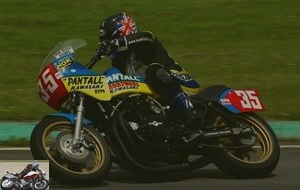 Test of the Moriwaki Kawasaki Z1B on the track
Test of the Moriwaki Kawasaki Z1B on the track
Taking a seat in the old Croz saddle reveals an unusual riding position compared to other early ’80s Superbikes I’ve ridden. With the apparently very high flat handlebars, you have no choice but to ride with your elbows out. But the wide handlebars provide excellent leverage for tight turns on British short circuits, as evidenced by the hairpins of Mallory Park and Pembrey. The protection offered by the small fairing is then surprisingly good for the helmet and the shoulders. But this is partly because we sit low on the bike, as inside, the saddle peaking at only 740 mm, a little lower than on a modern sports car. With the relatively high footrests, this leaves little room to move around on the Moriwaki. There is thus no question of hoping to put the knee in a curve. Look at the photos of Croz at the time and you will not see any sliders, which had yet been invented..
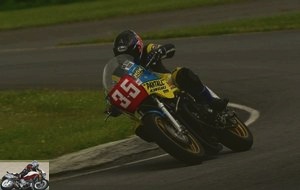 Wide handlebars provide good leverage for angle changes
Wide handlebars provide good leverage for angle changes
Gordon Pantall, a former Welsh TT rider, bought the bike from Moriwaki in late 1979 and has owned it ever since. But by restoring the well-used Kawasaki Z1 engine, it had not been able to stock up on the original 69.4mm Moriwaki pistons back to the 998cc configuration for the TT F1. Instead, he got a set of British 74mm Omega’s, which resulted in an engine now cubing at 1,135cc, with more power and a lot more torque than in Croz’s last race. The lower horsepower Z1 engine powering my P&M Kawasaki with which I raced Croz and Moriwaki 40 years ago had lower half-range torque than today’s motorcycle engine and was also sharper in the way it delivered its power, encouraging the use of the short five-speed gearbox to keep revving. It was not really a problem with the Moriwaki caliber which I rode in Pembrey and then again during the Festival of 1,000 bikes in Mallory Park a few weeks later, in the company of Croz himself (who rode on the Suzuki XR69 1980). In its 1.135 cm3 version, the engine pulls hard from 4,000 rpm with a linear power supply up to the red zone of 9,000 rpm, as indicated on the meter which remains the only instrumentation present on this air cooled motorcycle.
 Four-cylinder engine now delivers 119 horsepower
Four-cylinder engine now delivers 119 horsepower
Croz had warned me of the damage a missed report could cause. Fortunately, the gearbox settings are flawless, even by today’s standards. Coupled with the easy-to-operate clutch, shifting is simply instinctive and accompanied by the howl of the Moriwaki 4-into-1 exhaust. I had forgotten how noisy our F1 TT four-cylinder motorcycles were back then, at the beginning of the mandatory muffler! I still had to short-shifter when entering the left triple in front of the Pembrey paddock to avoid scraping my left boot on the track while trying to lower a gear on the lever while still being on the angle, to catch the fourth by taking the direction of Esses. The torquey nature of the engine allows you to do this, but it illustrates the risks of maintaining a road setup as so many Australians and New Zealanders have done, from Croz to Wayne Gardner to Chris Vermeulen. But hey, they all became World Champions !
 The Moriwaki Kawasaki Z1B offers excellent handling while remaining stable
The Moriwaki Kawasaki Z1B offers excellent handling while remaining stable
Using the wide handlebars to raise the Moriwaki out of a curve allows you to make the best use of the rear Dunlop tread and to put the throttle with the speedometer needle in the 5 / 6,000 rpm zone. We are then rewarded with a dazzling acceleration according to the standards of the time while we chain reports to the sound of the howling exhaust. Despite the height of the handlebars, there is no shimmy up front, even when changing angles quickly in a fast curve. The bike seems genuinely stuck to the asphalt as I take it straight down the left triple, or last gear in Woodlands. Revised frame geometry truly improves handling.
Cycle part
And while the vintage 18-inch Dunlop tires provide good grip despite the narrow rims they are fitted on, the extra torque provided by the larger bore requires extra care when sliding the rear over the larger ones. accelerations in the left triple.
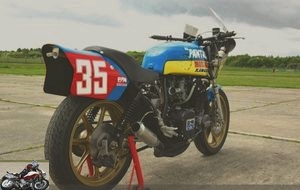 18-inch Dunlop tires provide excellent grip
18-inch Dunlop tires provide excellent grip
The front suspension is very smooth and under-damped to start with, until I stop and Gordon adds 10 psi of compressed air into the Kayaba forks to stiffen them. This solved the issue of the nose gear sinking and trying to fold up on itself on heavy braking before Pembrey’s very slow bobby pins. The wide handlebars are of great use here. The fork tuning also fixed the dribbling issue I suffered in the faster corners..
Braking
The Moriwaki’s brakes were Achilles heel when Croz rode it, robbing him of his best chance of victory in the TT F1 season ahead of the Grand Prix celebrities at Silverstone. This wasn’t the first time this has happened and although Lockheed calipers do the best they can to stop the bike, I found out in Pembrey that you have to squeeze the lever really, really hard for them. brake, because there is no real bite when gripping the lever. Also, although it didn’t happen to me during practice, Croz experienced some serious braking loss, caused by such a build-up of heat that the rotors became warped. The culprits aren’t hard to find and take the form of the 296mm stainless steel twin discs mounted on the bike. I find it surprising that Croz didn’t fix the problem by simply switching to the cast iron Brembo discs that all the other pilots were using. Used with the same Lockheed calipers as those fitted to the Moriwaki, my P&M provided predictable and efficient braking. As it is, not only do you have to brake hard on the rear 230mm disc for the Moriwaki to slow down properly in fourth before the hairpin, but also use some engine braking. Fortunately, there is no hint of dribbling, although I remain ready to operate the clutch lever if necessary….
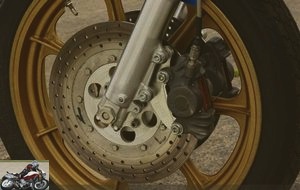 The front discs are the real weak point of the bike
The front discs are the real weak point of the bike
Conclusion
Mamoru Moriwaki’s achievement in creating the Crosby superbike has been to completely solve the handling issues associated with the stock frame, while providing an additional level of performance to the Kawasaki engine through its own parts and cylinder head settings. . If this did not allow the bike to have the extension of the Honda completely, it provided it with sufficient surplus vis-à-vis its private rivals, like me. To that extent, the Moriwaki has indeed played a pivotal role in the development of Crosby’s career, which is why she holds a special place in his heart. But the key ingredient to reaching the top was undoubtedly Graeme’s own talent and this is what this glorious piece of history on two wheels allowed him to present so effectively in the summer of 1979….
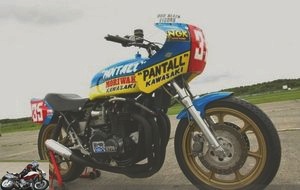 The Moriwaki Kawasaki Z1B
The Moriwaki Kawasaki Z1B
Strong points
- Acceleration
- Maneuverability
- Handling
Weak points
- Braking
Moriwaki Kawasaki Z1B technical sheet
Related articles
-
The first two-stroke of the Grands Prix 500 3-cylinder engine, 498 cm3, 82 hp and 59 Nm, 134 kg dry Ironic, really. Of the four Japanese manufacturers,…
-
Ducati 350 SCD motorcycle test
From the circuit to the road for the Italian sportswoman 4-stroke single cylinder, 340 cc, 42 hp, 210 km / h, 112 kg dry In 1954, the arrival of Fabio…
-
Honda CB1100R T-Rex motorcycle test
The best Post-Classic sports car ever built 4 cylinders in line, 1,156 cm3, 145 hp, 160 kg, Harris frame, 273 km / h A T-Rex is big, strong, powerful ……
-
Offenstadt Kawasaki 750 sports bike test
The H2 Monocoque Pilot-engineers are a rare breed, especially those who are equally expert in both disciplines and able to design innovative and unique…
-
Kawasaki ZZR 1400 motorcycle test
The Very High Speed Motorcycle according to Kawasaki We do three kilometers at 200 then at my signal, we open wide. Sitting next to me, assayer Kawa…
-
Aprilia Tuono 1000 Factory Pikes Peak motorcycle test
Survive and win V4 at 65 ° of 1.078 cm3, 170 hp, 170 kg, victory and record at the Pikes Peak Motorcycle racing is inherently perilous, but there aren’t…
-
Ducati Multistrada 950 S motorcycle test
Time concordance A few generations of bikers have dreamed of the ultimate bike, one that adapts to context and mood, needs and desires. As our ancestors…
-
Ducati SuperSport 950 S motorcycle test
Sublimated designation of origin Testastretta 11 ° twin cylinder, 937 cm3, 110 hp and 91.2 Nm, 210 kg Ducati sometimes seems to count in its production…
-
MV Agusta Rush 1000 motorcycle test
0 to 100 km / h in 2.9 seconds! All in excess ! 4 cylinders in line, 998 cm3, 212 hp and 116.5 Nm, 186 kg dry, 300 copies, 34,000 euros The success of…
-
Homemade hotrod 649cc Triumph twin, Norton Manx clutch and fork, 48hp, 129kg dry Superbike racing and its Supersport derivative are largely responsible…
really a good bike !!!
well done for the article
V